CHCECE002: Comprehensive Guide to Child Health and Safety Procedures
VerifiedAdded on 2020/07/23
|41
|12793
|1236
Homework Assignment
AI Summary
This document is a comprehensive assignment on CHCECE002, focusing on ensuring the health and safety of children in childcare settings. The assignment covers a wide range of topics, including collaboration with families, medication administration procedures, hygiene practices, creating quiet areas, daily record keeping, supporting children's toilet training, handwashing protocols, cleaning and sanitizing procedures, identifying and responding to illnesses, handling medical emergencies, and communication with parents. It also delves into supervision plans, safety regulations, equipment checks, storage of chemicals, release of children to authorized persons, sun protection, equipment inspections, anaphylaxis and asthma management plans, and relevant regulations from the Education and Care Services National Regulations 2011. The assignment includes formative and summative assessments, requiring the student to demonstrate understanding of the National Quality Framework (NQF), National Quality Standards (NQS), and the Early Years Learning Framework (EYLF) related to child health and safety.
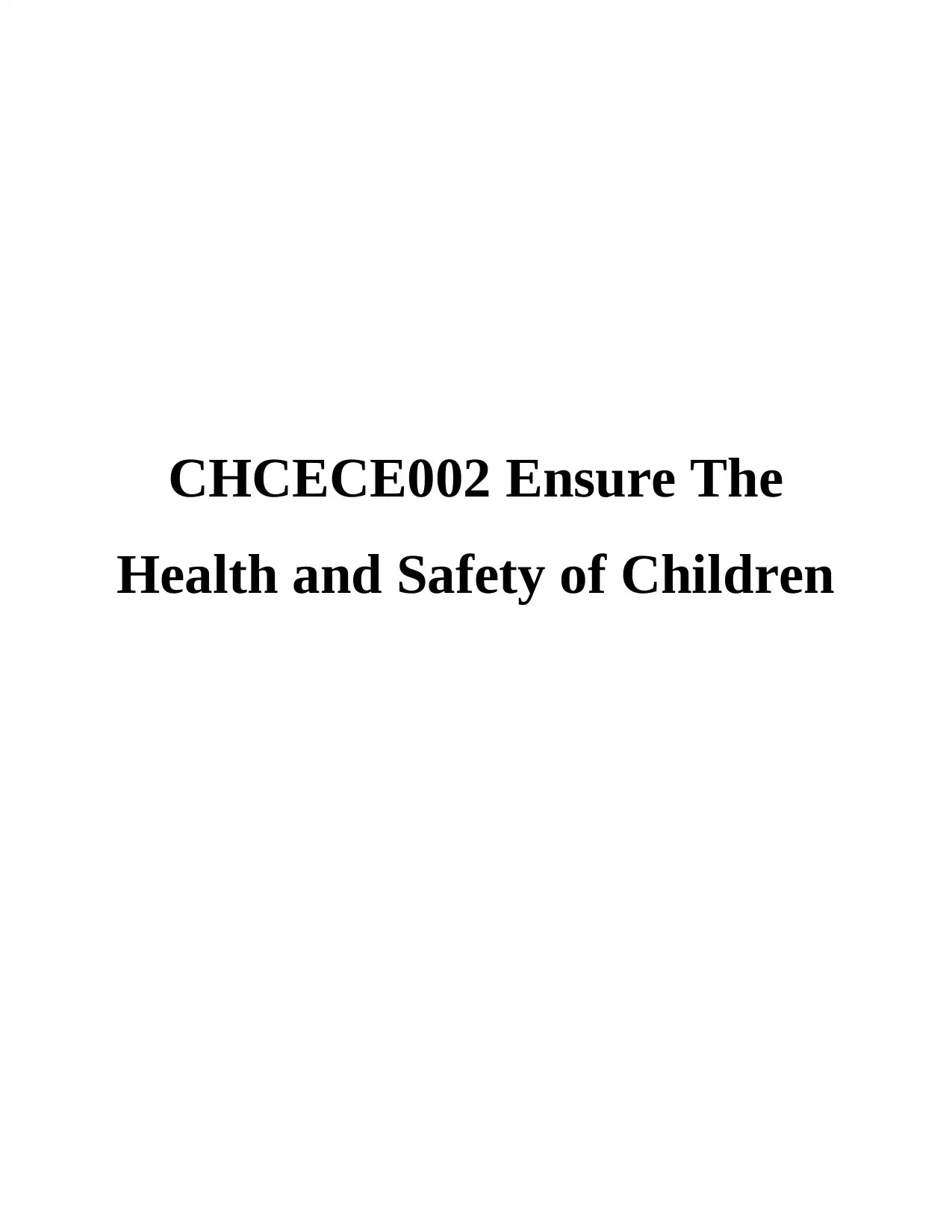
CHCECE002 Ensure The
Health and Safety of Children
Health and Safety of Children
Paraphrase This Document
Need a fresh take? Get an instant paraphrase of this document with our AI Paraphraser
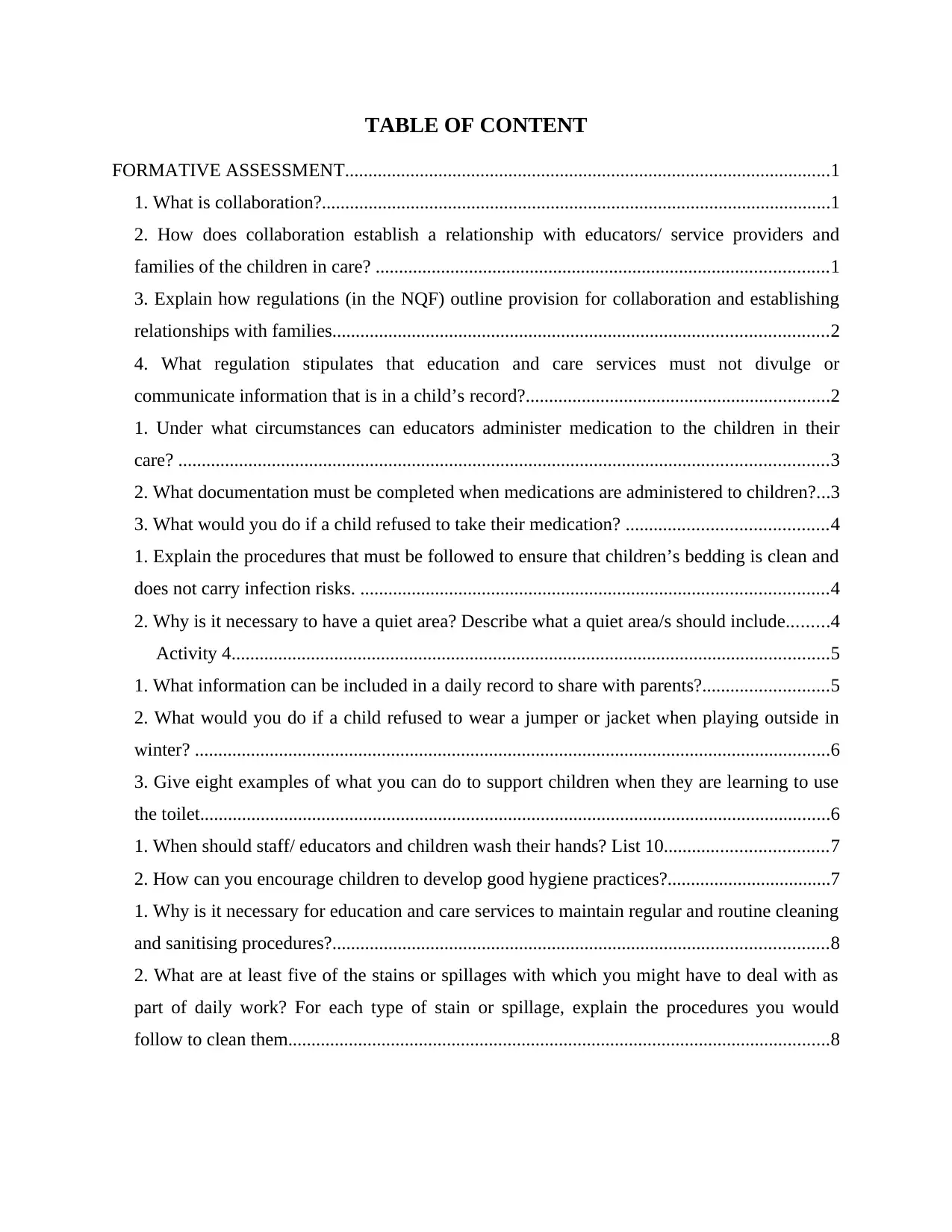
TABLE OF CONTENT
FORMATIVE ASSESSMENT........................................................................................................1
1. What is collaboration?.............................................................................................................1
2. How does collaboration establish a relationship with educators/ service providers and
families of the children in care? .................................................................................................1
3. Explain how regulations (in the NQF) outline provision for collaboration and establishing
relationships with families..........................................................................................................2
4. What regulation stipulates that education and care services must not divulge or
communicate information that is in a child’s record?.................................................................2
1. Under what circumstances can educators administer medication to the children in their
care? ...........................................................................................................................................3
2. What documentation must be completed when medications are administered to children?...3
3. What would you do if a child refused to take their medication? ...........................................4
1. Explain the procedures that must be followed to ensure that children’s bedding is clean and
does not carry infection risks. ....................................................................................................4
2. Why is it necessary to have a quiet area? Describe what a quiet area/s should include.........4
Activity 4................................................................................................................................5
1. What information can be included in a daily record to share with parents?...........................5
2. What would you do if a child refused to wear a jumper or jacket when playing outside in
winter? ........................................................................................................................................6
3. Give eight examples of what you can do to support children when they are learning to use
the toilet.......................................................................................................................................6
1. When should staff/ educators and children wash their hands? List 10...................................7
2. How can you encourage children to develop good hygiene practices?...................................7
1. Why is it necessary for education and care services to maintain regular and routine cleaning
and sanitising procedures?..........................................................................................................8
2. What are at least five of the stains or spillages with which you might have to deal with as
part of daily work? For each type of stain or spillage, explain the procedures you would
follow to clean them....................................................................................................................8
FORMATIVE ASSESSMENT........................................................................................................1
1. What is collaboration?.............................................................................................................1
2. How does collaboration establish a relationship with educators/ service providers and
families of the children in care? .................................................................................................1
3. Explain how regulations (in the NQF) outline provision for collaboration and establishing
relationships with families..........................................................................................................2
4. What regulation stipulates that education and care services must not divulge or
communicate information that is in a child’s record?.................................................................2
1. Under what circumstances can educators administer medication to the children in their
care? ...........................................................................................................................................3
2. What documentation must be completed when medications are administered to children?...3
3. What would you do if a child refused to take their medication? ...........................................4
1. Explain the procedures that must be followed to ensure that children’s bedding is clean and
does not carry infection risks. ....................................................................................................4
2. Why is it necessary to have a quiet area? Describe what a quiet area/s should include.........4
Activity 4................................................................................................................................5
1. What information can be included in a daily record to share with parents?...........................5
2. What would you do if a child refused to wear a jumper or jacket when playing outside in
winter? ........................................................................................................................................6
3. Give eight examples of what you can do to support children when they are learning to use
the toilet.......................................................................................................................................6
1. When should staff/ educators and children wash their hands? List 10...................................7
2. How can you encourage children to develop good hygiene practices?...................................7
1. Why is it necessary for education and care services to maintain regular and routine cleaning
and sanitising procedures?..........................................................................................................8
2. What are at least five of the stains or spillages with which you might have to deal with as
part of daily work? For each type of stain or spillage, explain the procedures you would
follow to clean them....................................................................................................................8
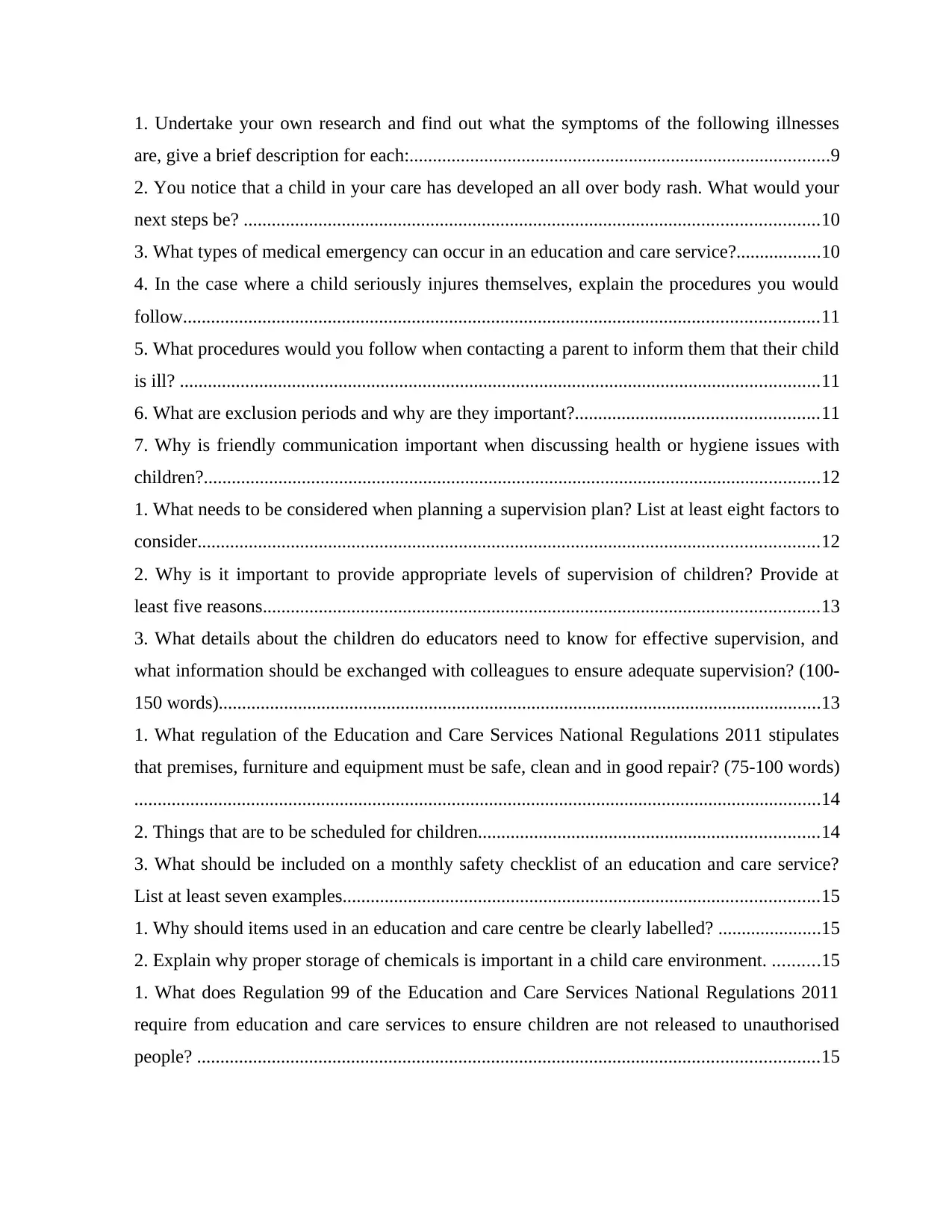
1. Undertake your own research and find out what the symptoms of the following illnesses
are, give a brief description for each:..........................................................................................9
2. You notice that a child in your care has developed an all over body rash. What would your
next steps be? ...........................................................................................................................10
3. What types of medical emergency can occur in an education and care service?..................10
4. In the case where a child seriously injures themselves, explain the procedures you would
follow........................................................................................................................................11
5. What procedures would you follow when contacting a parent to inform them that their child
is ill? .........................................................................................................................................11
6. What are exclusion periods and why are they important?....................................................11
7. Why is friendly communication important when discussing health or hygiene issues with
children?....................................................................................................................................12
1. What needs to be considered when planning a supervision plan? List at least eight factors to
consider.....................................................................................................................................12
2. Why is it important to provide appropriate levels of supervision of children? Provide at
least five reasons.......................................................................................................................13
3. What details about the children do educators need to know for effective supervision, and
what information should be exchanged with colleagues to ensure adequate supervision? (100-
150 words).................................................................................................................................13
1. What regulation of the Education and Care Services National Regulations 2011 stipulates
that premises, furniture and equipment must be safe, clean and in good repair? (75-100 words)
...................................................................................................................................................14
2. Things that are to be scheduled for children.........................................................................14
3. What should be included on a monthly safety checklist of an education and care service?
List at least seven examples......................................................................................................15
1. Why should items used in an education and care centre be clearly labelled? ......................15
2. Explain why proper storage of chemicals is important in a child care environment. ..........15
1. What does Regulation 99 of the Education and Care Services National Regulations 2011
require from education and care services to ensure children are not released to unauthorised
people? .....................................................................................................................................15
are, give a brief description for each:..........................................................................................9
2. You notice that a child in your care has developed an all over body rash. What would your
next steps be? ...........................................................................................................................10
3. What types of medical emergency can occur in an education and care service?..................10
4. In the case where a child seriously injures themselves, explain the procedures you would
follow........................................................................................................................................11
5. What procedures would you follow when contacting a parent to inform them that their child
is ill? .........................................................................................................................................11
6. What are exclusion periods and why are they important?....................................................11
7. Why is friendly communication important when discussing health or hygiene issues with
children?....................................................................................................................................12
1. What needs to be considered when planning a supervision plan? List at least eight factors to
consider.....................................................................................................................................12
2. Why is it important to provide appropriate levels of supervision of children? Provide at
least five reasons.......................................................................................................................13
3. What details about the children do educators need to know for effective supervision, and
what information should be exchanged with colleagues to ensure adequate supervision? (100-
150 words).................................................................................................................................13
1. What regulation of the Education and Care Services National Regulations 2011 stipulates
that premises, furniture and equipment must be safe, clean and in good repair? (75-100 words)
...................................................................................................................................................14
2. Things that are to be scheduled for children.........................................................................14
3. What should be included on a monthly safety checklist of an education and care service?
List at least seven examples......................................................................................................15
1. Why should items used in an education and care centre be clearly labelled? ......................15
2. Explain why proper storage of chemicals is important in a child care environment. ..........15
1. What does Regulation 99 of the Education and Care Services National Regulations 2011
require from education and care services to ensure children are not released to unauthorised
people? .....................................................................................................................................15
⊘ This is a preview!⊘
Do you want full access?
Subscribe today to unlock all pages.

Trusted by 1+ million students worldwide
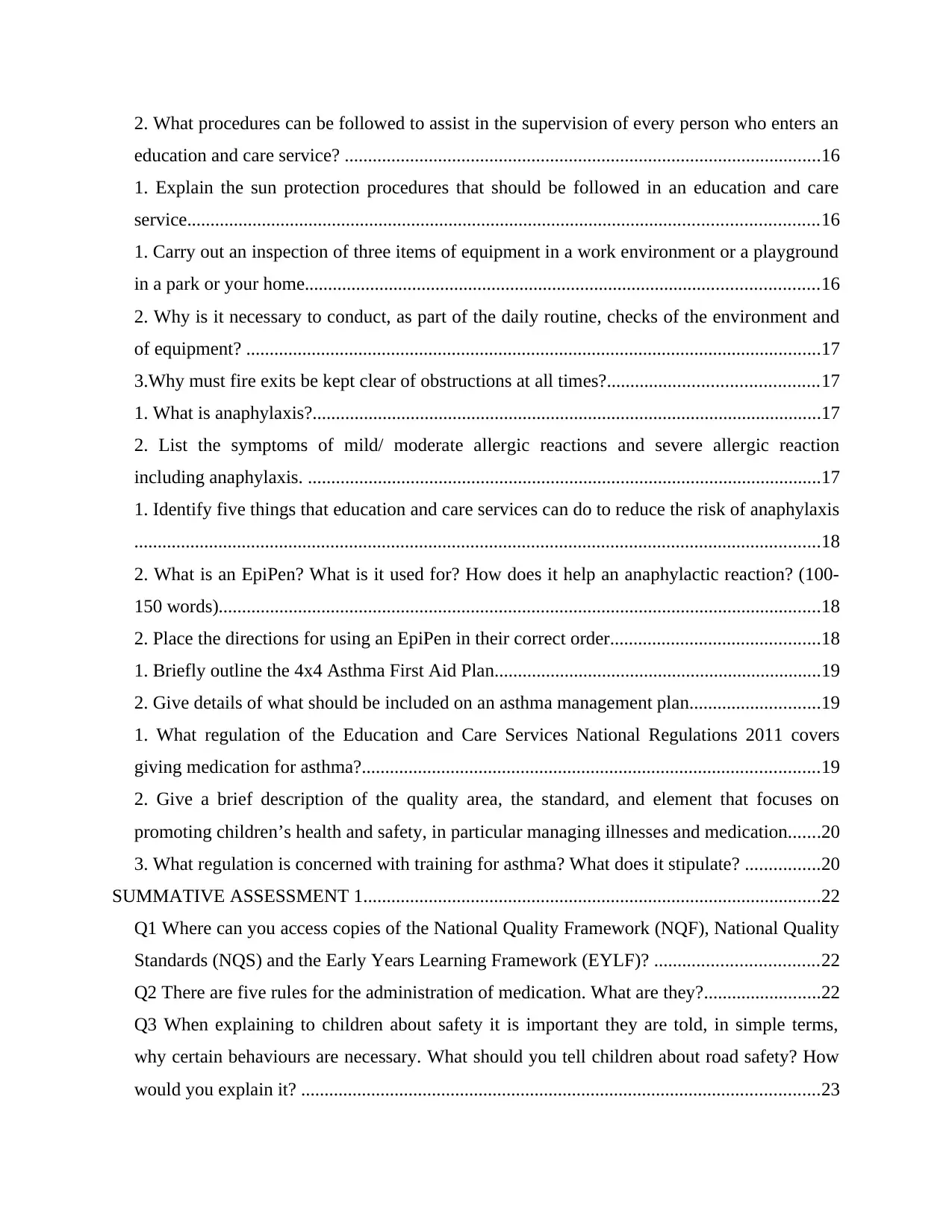
2. What procedures can be followed to assist in the supervision of every person who enters an
education and care service? ......................................................................................................16
1. Explain the sun protection procedures that should be followed in an education and care
service.......................................................................................................................................16
1. Carry out an inspection of three items of equipment in a work environment or a playground
in a park or your home..............................................................................................................16
2. Why is it necessary to conduct, as part of the daily routine, checks of the environment and
of equipment? ...........................................................................................................................17
3.Why must fire exits be kept clear of obstructions at all times?.............................................17
1. What is anaphylaxis?.............................................................................................................17
2. List the symptoms of mild/ moderate allergic reactions and severe allergic reaction
including anaphylaxis. ..............................................................................................................17
1. Identify five things that education and care services can do to reduce the risk of anaphylaxis
...................................................................................................................................................18
2. What is an EpiPen? What is it used for? How does it help an anaphylactic reaction? (100-
150 words).................................................................................................................................18
2. Place the directions for using an EpiPen in their correct order.............................................18
1. Briefly outline the 4x4 Asthma First Aid Plan......................................................................19
2. Give details of what should be included on an asthma management plan............................19
1. What regulation of the Education and Care Services National Regulations 2011 covers
giving medication for asthma?..................................................................................................19
2. Give a brief description of the quality area, the standard, and element that focuses on
promoting children’s health and safety, in particular managing illnesses and medication.......20
3. What regulation is concerned with training for asthma? What does it stipulate? ................20
SUMMATIVE ASSESSMENT 1..................................................................................................22
Q1 Where can you access copies of the National Quality Framework (NQF), National Quality
Standards (NQS) and the Early Years Learning Framework (EYLF)? ...................................22
Q2 There are five rules for the administration of medication. What are they?.........................22
Q3 When explaining to children about safety it is important they are told, in simple terms,
why certain behaviours are necessary. What should you tell children about road safety? How
would you explain it? ...............................................................................................................23
education and care service? ......................................................................................................16
1. Explain the sun protection procedures that should be followed in an education and care
service.......................................................................................................................................16
1. Carry out an inspection of three items of equipment in a work environment or a playground
in a park or your home..............................................................................................................16
2. Why is it necessary to conduct, as part of the daily routine, checks of the environment and
of equipment? ...........................................................................................................................17
3.Why must fire exits be kept clear of obstructions at all times?.............................................17
1. What is anaphylaxis?.............................................................................................................17
2. List the symptoms of mild/ moderate allergic reactions and severe allergic reaction
including anaphylaxis. ..............................................................................................................17
1. Identify five things that education and care services can do to reduce the risk of anaphylaxis
...................................................................................................................................................18
2. What is an EpiPen? What is it used for? How does it help an anaphylactic reaction? (100-
150 words).................................................................................................................................18
2. Place the directions for using an EpiPen in their correct order.............................................18
1. Briefly outline the 4x4 Asthma First Aid Plan......................................................................19
2. Give details of what should be included on an asthma management plan............................19
1. What regulation of the Education and Care Services National Regulations 2011 covers
giving medication for asthma?..................................................................................................19
2. Give a brief description of the quality area, the standard, and element that focuses on
promoting children’s health and safety, in particular managing illnesses and medication.......20
3. What regulation is concerned with training for asthma? What does it stipulate? ................20
SUMMATIVE ASSESSMENT 1..................................................................................................22
Q1 Where can you access copies of the National Quality Framework (NQF), National Quality
Standards (NQS) and the Early Years Learning Framework (EYLF)? ...................................22
Q2 There are five rules for the administration of medication. What are they?.........................22
Q3 When explaining to children about safety it is important they are told, in simple terms,
why certain behaviours are necessary. What should you tell children about road safety? How
would you explain it? ...............................................................................................................23
Paraphrase This Document
Need a fresh take? Get an instant paraphrase of this document with our AI Paraphraser
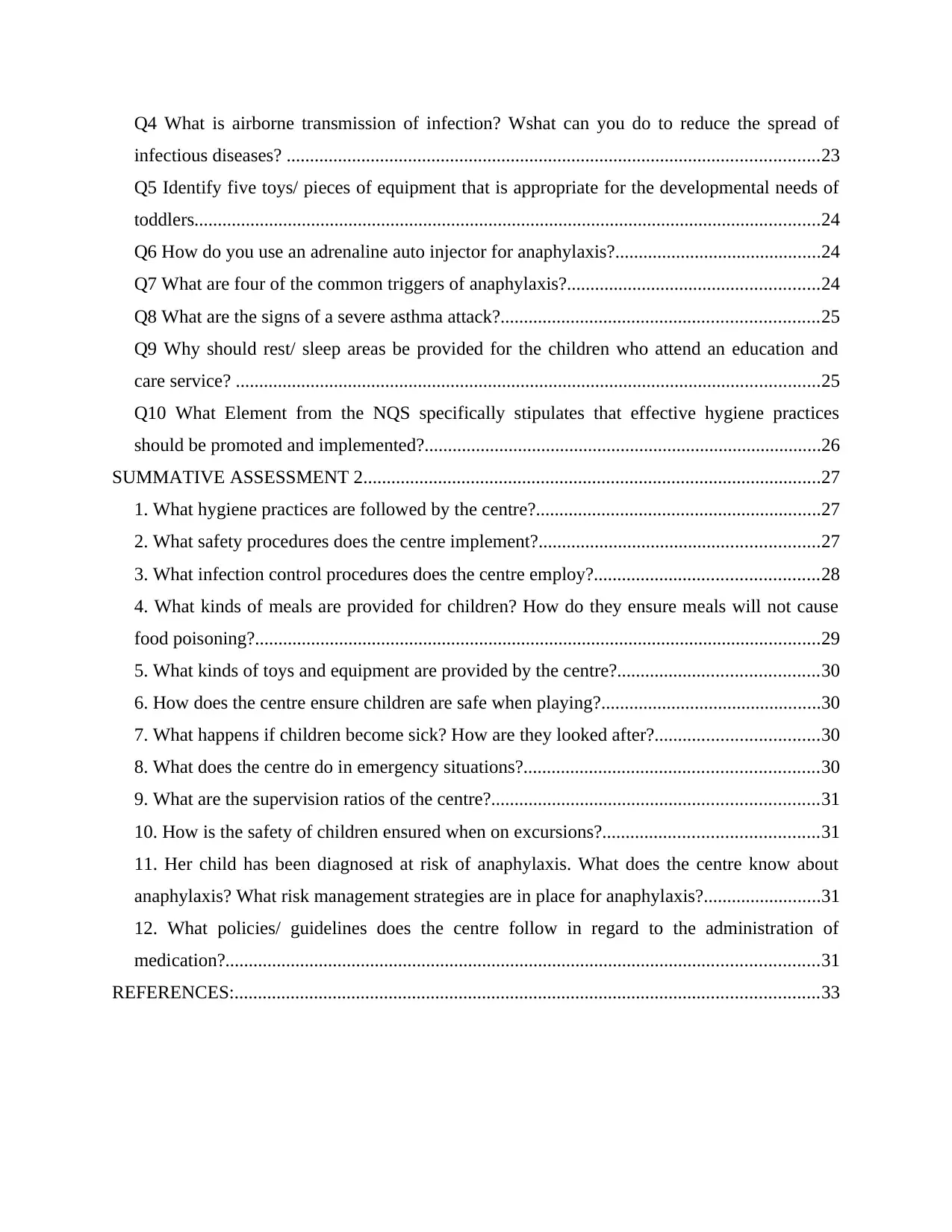
Q4 What is airborne transmission of infection? Wshat can you do to reduce the spread of
infectious diseases? ..................................................................................................................23
Q5 Identify five toys/ pieces of equipment that is appropriate for the developmental needs of
toddlers......................................................................................................................................24
Q6 How do you use an adrenaline auto injector for anaphylaxis?............................................24
Q7 What are four of the common triggers of anaphylaxis?......................................................24
Q8 What are the signs of a severe asthma attack?....................................................................25
Q9 Why should rest/ sleep areas be provided for the children who attend an education and
care service? .............................................................................................................................25
Q10 What Element from the NQS specifically stipulates that effective hygiene practices
should be promoted and implemented?.....................................................................................26
SUMMATIVE ASSESSMENT 2..................................................................................................27
1. What hygiene practices are followed by the centre?.............................................................27
2. What safety procedures does the centre implement?............................................................27
3. What infection control procedures does the centre employ?................................................28
4. What kinds of meals are provided for children? How do they ensure meals will not cause
food poisoning?.........................................................................................................................29
5. What kinds of toys and equipment are provided by the centre?...........................................30
6. How does the centre ensure children are safe when playing?...............................................30
7. What happens if children become sick? How are they looked after?...................................30
8. What does the centre do in emergency situations?...............................................................30
9. What are the supervision ratios of the centre?......................................................................31
10. How is the safety of children ensured when on excursions?..............................................31
11. Her child has been diagnosed at risk of anaphylaxis. What does the centre know about
anaphylaxis? What risk management strategies are in place for anaphylaxis?.........................31
12. What policies/ guidelines does the centre follow in regard to the administration of
medication?...............................................................................................................................31
REFERENCES:.............................................................................................................................33
infectious diseases? ..................................................................................................................23
Q5 Identify five toys/ pieces of equipment that is appropriate for the developmental needs of
toddlers......................................................................................................................................24
Q6 How do you use an adrenaline auto injector for anaphylaxis?............................................24
Q7 What are four of the common triggers of anaphylaxis?......................................................24
Q8 What are the signs of a severe asthma attack?....................................................................25
Q9 Why should rest/ sleep areas be provided for the children who attend an education and
care service? .............................................................................................................................25
Q10 What Element from the NQS specifically stipulates that effective hygiene practices
should be promoted and implemented?.....................................................................................26
SUMMATIVE ASSESSMENT 2..................................................................................................27
1. What hygiene practices are followed by the centre?.............................................................27
2. What safety procedures does the centre implement?............................................................27
3. What infection control procedures does the centre employ?................................................28
4. What kinds of meals are provided for children? How do they ensure meals will not cause
food poisoning?.........................................................................................................................29
5. What kinds of toys and equipment are provided by the centre?...........................................30
6. How does the centre ensure children are safe when playing?...............................................30
7. What happens if children become sick? How are they looked after?...................................30
8. What does the centre do in emergency situations?...............................................................30
9. What are the supervision ratios of the centre?......................................................................31
10. How is the safety of children ensured when on excursions?..............................................31
11. Her child has been diagnosed at risk of anaphylaxis. What does the centre know about
anaphylaxis? What risk management strategies are in place for anaphylaxis?.........................31
12. What policies/ guidelines does the centre follow in regard to the administration of
medication?...............................................................................................................................31
REFERENCES:.............................................................................................................................33
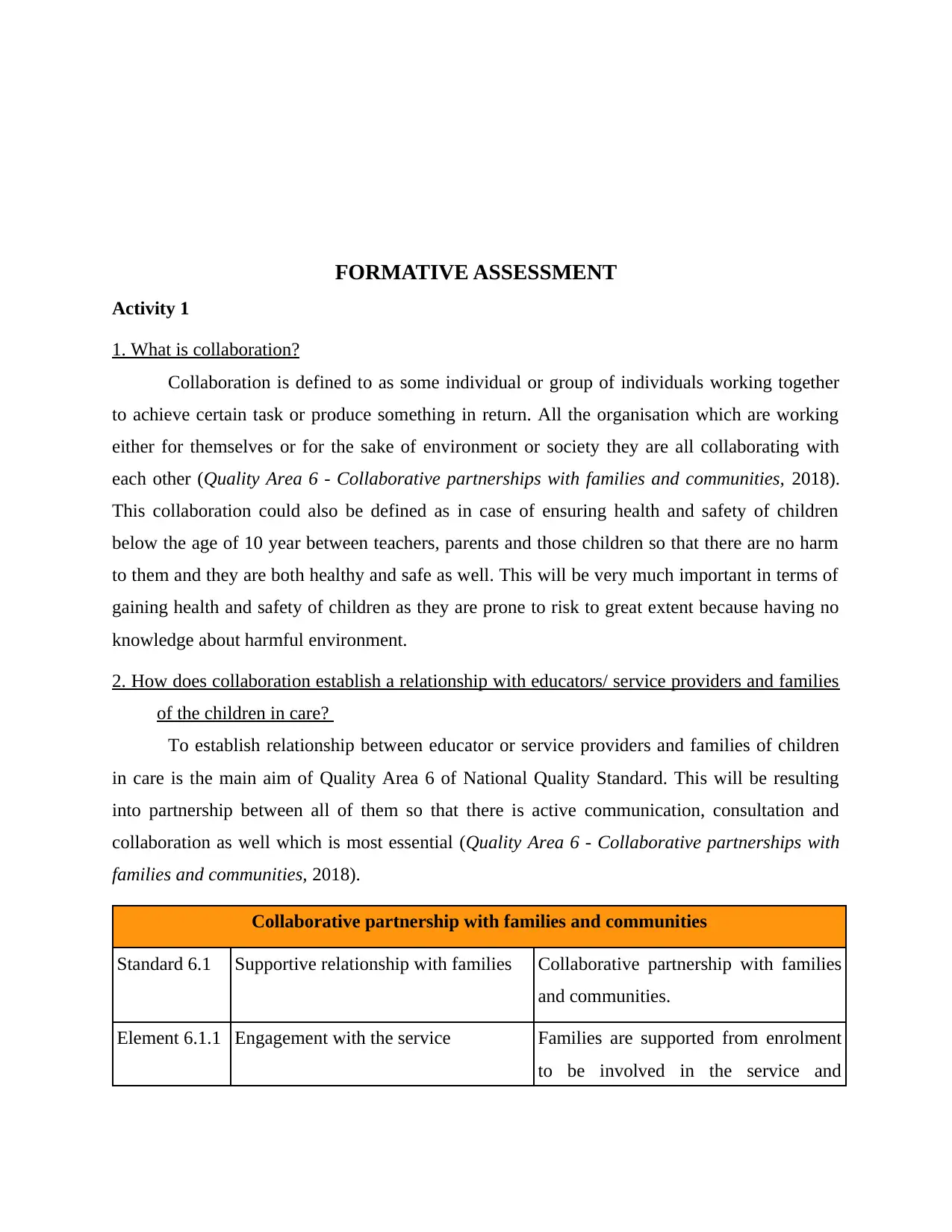
FORMATIVE ASSESSMENT
Activity 1
1. What is collaboration?
Collaboration is defined to as some individual or group of individuals working together
to achieve certain task or produce something in return. All the organisation which are working
either for themselves or for the sake of environment or society they are all collaborating with
each other (Quality Area 6 - Collaborative partnerships with families and communities, 2018).
This collaboration could also be defined as in case of ensuring health and safety of children
below the age of 10 year between teachers, parents and those children so that there are no harm
to them and they are both healthy and safe as well. This will be very much important in terms of
gaining health and safety of children as they are prone to risk to great extent because having no
knowledge about harmful environment.
2. How does collaboration establish a relationship with educators/ service providers and families
of the children in care?
To establish relationship between educator or service providers and families of children
in care is the main aim of Quality Area 6 of National Quality Standard. This will be resulting
into partnership between all of them so that there is active communication, consultation and
collaboration as well which is most essential (Quality Area 6 - Collaborative partnerships with
families and communities, 2018).
Collaborative partnership with families and communities
Standard 6.1 Supportive relationship with families Collaborative partnership with families
and communities.
Element 6.1.1 Engagement with the service Families are supported from enrolment
to be involved in the service and
Activity 1
1. What is collaboration?
Collaboration is defined to as some individual or group of individuals working together
to achieve certain task or produce something in return. All the organisation which are working
either for themselves or for the sake of environment or society they are all collaborating with
each other (Quality Area 6 - Collaborative partnerships with families and communities, 2018).
This collaboration could also be defined as in case of ensuring health and safety of children
below the age of 10 year between teachers, parents and those children so that there are no harm
to them and they are both healthy and safe as well. This will be very much important in terms of
gaining health and safety of children as they are prone to risk to great extent because having no
knowledge about harmful environment.
2. How does collaboration establish a relationship with educators/ service providers and families
of the children in care?
To establish relationship between educator or service providers and families of children
in care is the main aim of Quality Area 6 of National Quality Standard. This will be resulting
into partnership between all of them so that there is active communication, consultation and
collaboration as well which is most essential (Quality Area 6 - Collaborative partnerships with
families and communities, 2018).
Collaborative partnership with families and communities
Standard 6.1 Supportive relationship with families Collaborative partnership with families
and communities.
Element 6.1.1 Engagement with the service Families are supported from enrolment
to be involved in the service and
⊘ This is a preview!⊘
Do you want full access?
Subscribe today to unlock all pages.

Trusted by 1+ million students worldwide
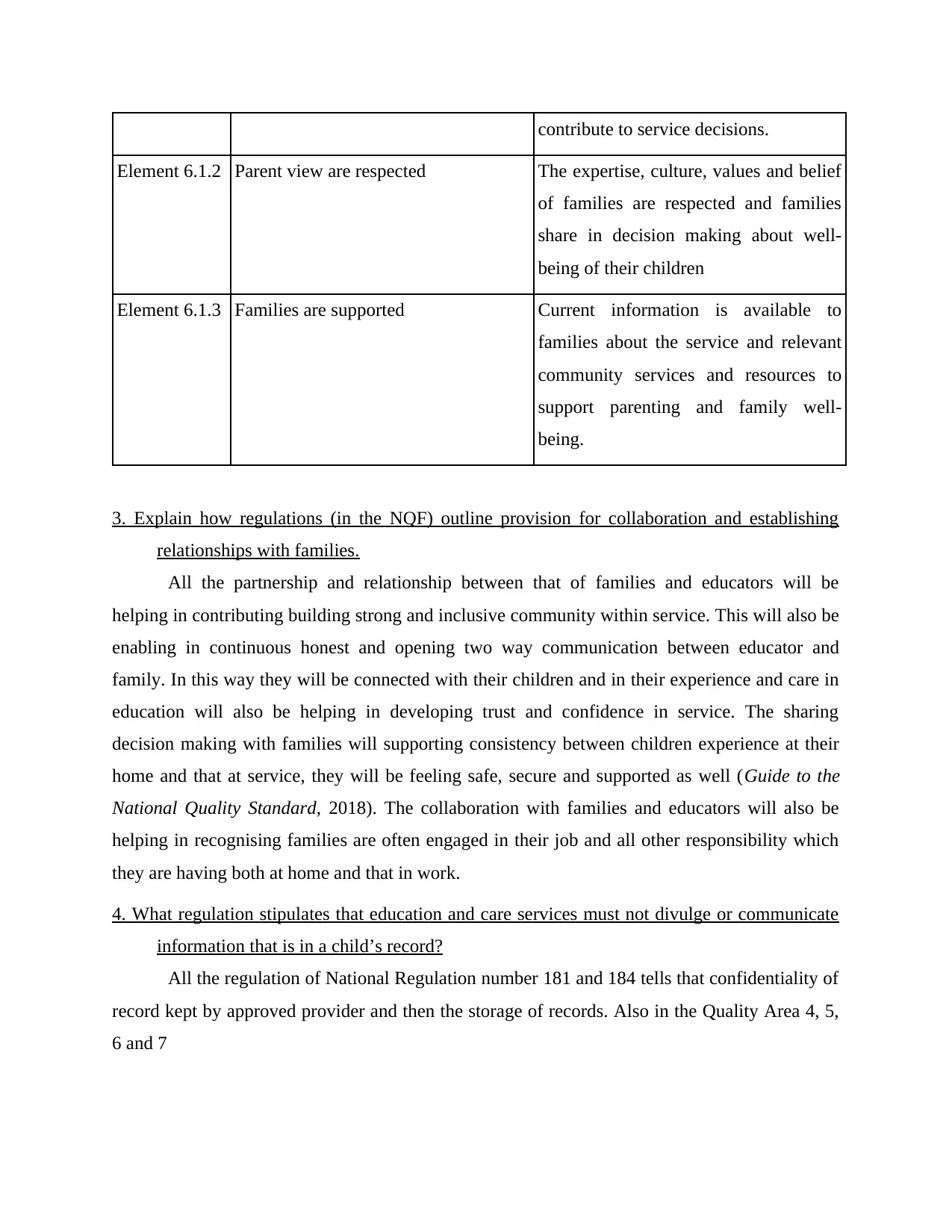
contribute to service decisions.
Element 6.1.2 Parent view are respected The expertise, culture, values and belief
of families are respected and families
share in decision making about well-
being of their children
Element 6.1.3 Families are supported Current information is available to
families about the service and relevant
community services and resources to
support parenting and family well-
being.
3. Explain how regulations (in the NQF) outline provision for collaboration and establishing
relationships with families.
All the partnership and relationship between that of families and educators will be
helping in contributing building strong and inclusive community within service. This will also be
enabling in continuous honest and opening two way communication between educator and
family. In this way they will be connected with their children and in their experience and care in
education will also be helping in developing trust and confidence in service. The sharing
decision making with families will supporting consistency between children experience at their
home and that at service, they will be feeling safe, secure and supported as well (Guide to the
National Quality Standard, 2018). The collaboration with families and educators will also be
helping in recognising families are often engaged in their job and all other responsibility which
they are having both at home and that in work.
4. What regulation stipulates that education and care services must not divulge or communicate
information that is in a child’s record?
All the regulation of National Regulation number 181 and 184 tells that confidentiality of
record kept by approved provider and then the storage of records. Also in the Quality Area 4, 5,
6 and 7
Element 6.1.2 Parent view are respected The expertise, culture, values and belief
of families are respected and families
share in decision making about well-
being of their children
Element 6.1.3 Families are supported Current information is available to
families about the service and relevant
community services and resources to
support parenting and family well-
being.
3. Explain how regulations (in the NQF) outline provision for collaboration and establishing
relationships with families.
All the partnership and relationship between that of families and educators will be
helping in contributing building strong and inclusive community within service. This will also be
enabling in continuous honest and opening two way communication between educator and
family. In this way they will be connected with their children and in their experience and care in
education will also be helping in developing trust and confidence in service. The sharing
decision making with families will supporting consistency between children experience at their
home and that at service, they will be feeling safe, secure and supported as well (Guide to the
National Quality Standard, 2018). The collaboration with families and educators will also be
helping in recognising families are often engaged in their job and all other responsibility which
they are having both at home and that in work.
4. What regulation stipulates that education and care services must not divulge or communicate
information that is in a child’s record?
All the regulation of National Regulation number 181 and 184 tells that confidentiality of
record kept by approved provider and then the storage of records. Also in the Quality Area 4, 5,
6 and 7
Paraphrase This Document
Need a fresh take? Get an instant paraphrase of this document with our AI Paraphraser
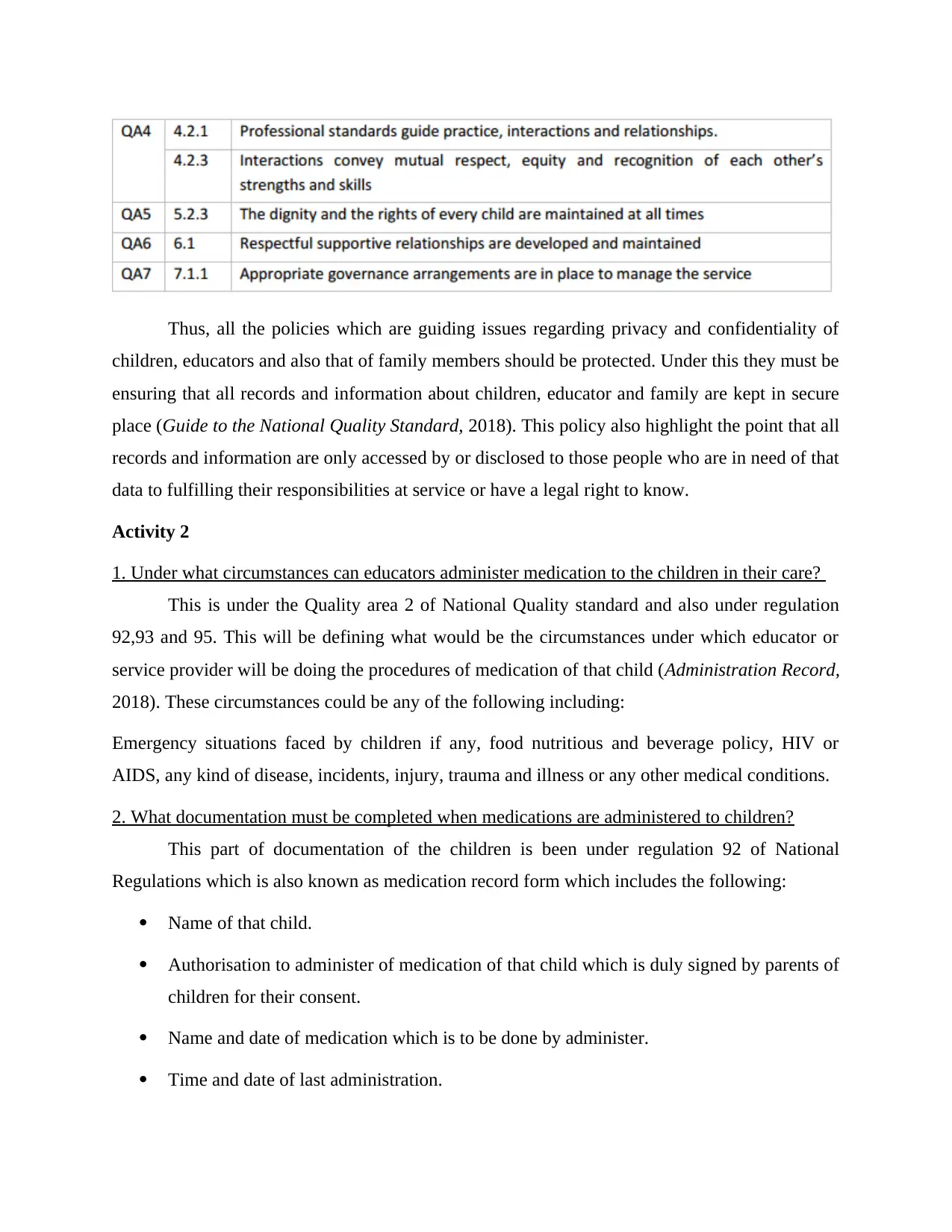
Thus, all the policies which are guiding issues regarding privacy and confidentiality of
children, educators and also that of family members should be protected. Under this they must be
ensuring that all records and information about children, educator and family are kept in secure
place (Guide to the National Quality Standard, 2018). This policy also highlight the point that all
records and information are only accessed by or disclosed to those people who are in need of that
data to fulfilling their responsibilities at service or have a legal right to know.
Activity 2
1. Under what circumstances can educators administer medication to the children in their care?
This is under the Quality area 2 of National Quality standard and also under regulation
92,93 and 95. This will be defining what would be the circumstances under which educator or
service provider will be doing the procedures of medication of that child (Administration Record,
2018). These circumstances could be any of the following including:
Emergency situations faced by children if any, food nutritious and beverage policy, HIV or
AIDS, any kind of disease, incidents, injury, trauma and illness or any other medical conditions.
2. What documentation must be completed when medications are administered to children?
This part of documentation of the children is been under regulation 92 of National
Regulations which is also known as medication record form which includes the following:
Name of that child.
Authorisation to administer of medication of that child which is duly signed by parents of
children for their consent.
Name and date of medication which is to be done by administer.
Time and date of last administration.
children, educators and also that of family members should be protected. Under this they must be
ensuring that all records and information about children, educator and family are kept in secure
place (Guide to the National Quality Standard, 2018). This policy also highlight the point that all
records and information are only accessed by or disclosed to those people who are in need of that
data to fulfilling their responsibilities at service or have a legal right to know.
Activity 2
1. Under what circumstances can educators administer medication to the children in their care?
This is under the Quality area 2 of National Quality standard and also under regulation
92,93 and 95. This will be defining what would be the circumstances under which educator or
service provider will be doing the procedures of medication of that child (Administration Record,
2018). These circumstances could be any of the following including:
Emergency situations faced by children if any, food nutritious and beverage policy, HIV or
AIDS, any kind of disease, incidents, injury, trauma and illness or any other medical conditions.
2. What documentation must be completed when medications are administered to children?
This part of documentation of the children is been under regulation 92 of National
Regulations which is also known as medication record form which includes the following:
Name of that child.
Authorisation to administer of medication of that child which is duly signed by parents of
children for their consent.
Name and date of medication which is to be done by administer.
Time and date of last administration.
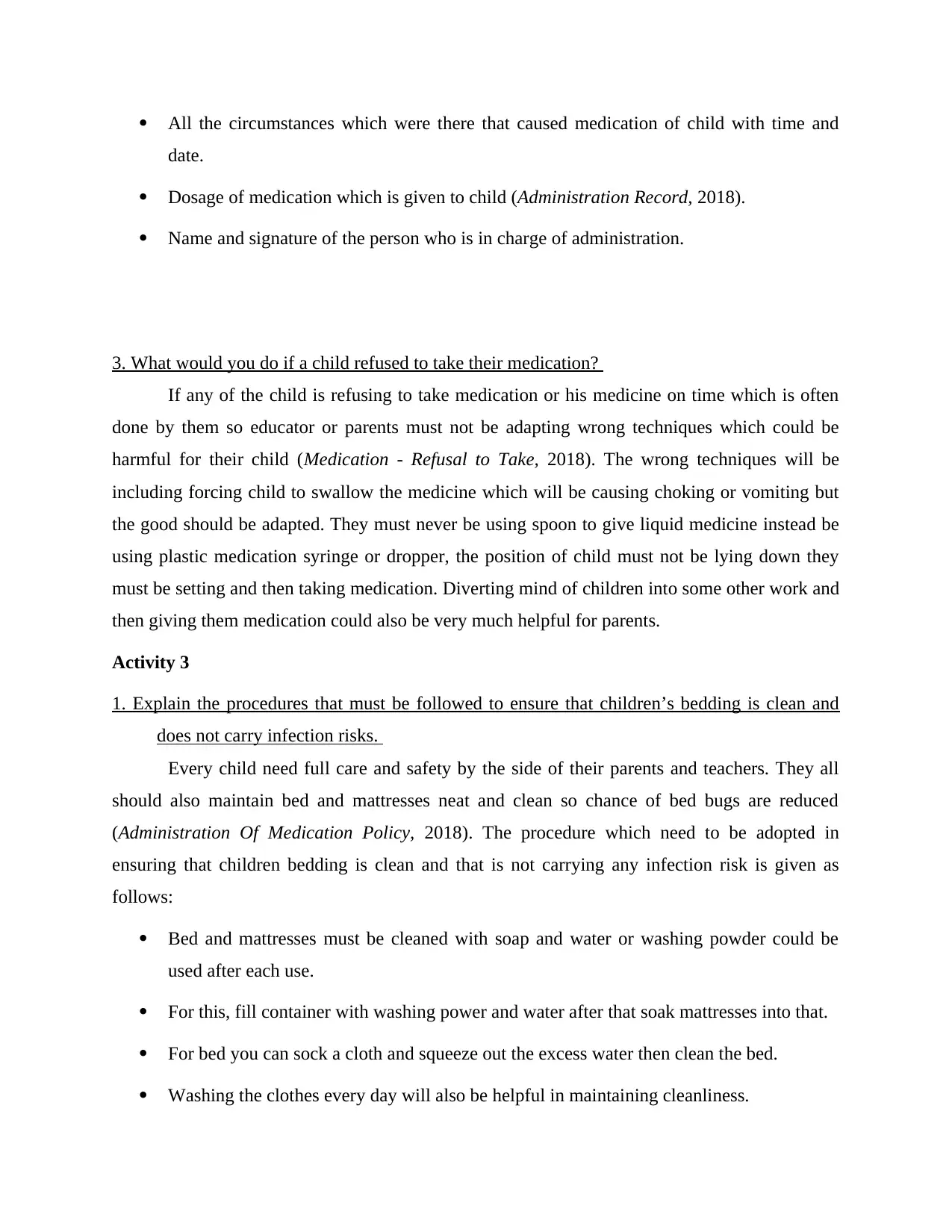
All the circumstances which were there that caused medication of child with time and
date.
Dosage of medication which is given to child (Administration Record, 2018).
Name and signature of the person who is in charge of administration.
3. What would you do if a child refused to take their medication?
If any of the child is refusing to take medication or his medicine on time which is often
done by them so educator or parents must not be adapting wrong techniques which could be
harmful for their child (Medication - Refusal to Take, 2018). The wrong techniques will be
including forcing child to swallow the medicine which will be causing choking or vomiting but
the good should be adapted. They must never be using spoon to give liquid medicine instead be
using plastic medication syringe or dropper, the position of child must not be lying down they
must be setting and then taking medication. Diverting mind of children into some other work and
then giving them medication could also be very much helpful for parents.
Activity 3
1. Explain the procedures that must be followed to ensure that children’s bedding is clean and
does not carry infection risks.
Every child need full care and safety by the side of their parents and teachers. They all
should also maintain bed and mattresses neat and clean so chance of bed bugs are reduced
(Administration Of Medication Policy, 2018). The procedure which need to be adopted in
ensuring that children bedding is clean and that is not carrying any infection risk is given as
follows:
Bed and mattresses must be cleaned with soap and water or washing powder could be
used after each use.
For this, fill container with washing power and water after that soak mattresses into that.
For bed you can sock a cloth and squeeze out the excess water then clean the bed.
Washing the clothes every day will also be helpful in maintaining cleanliness.
date.
Dosage of medication which is given to child (Administration Record, 2018).
Name and signature of the person who is in charge of administration.
3. What would you do if a child refused to take their medication?
If any of the child is refusing to take medication or his medicine on time which is often
done by them so educator or parents must not be adapting wrong techniques which could be
harmful for their child (Medication - Refusal to Take, 2018). The wrong techniques will be
including forcing child to swallow the medicine which will be causing choking or vomiting but
the good should be adapted. They must never be using spoon to give liquid medicine instead be
using plastic medication syringe or dropper, the position of child must not be lying down they
must be setting and then taking medication. Diverting mind of children into some other work and
then giving them medication could also be very much helpful for parents.
Activity 3
1. Explain the procedures that must be followed to ensure that children’s bedding is clean and
does not carry infection risks.
Every child need full care and safety by the side of their parents and teachers. They all
should also maintain bed and mattresses neat and clean so chance of bed bugs are reduced
(Administration Of Medication Policy, 2018). The procedure which need to be adopted in
ensuring that children bedding is clean and that is not carrying any infection risk is given as
follows:
Bed and mattresses must be cleaned with soap and water or washing powder could be
used after each use.
For this, fill container with washing power and water after that soak mattresses into that.
For bed you can sock a cloth and squeeze out the excess water then clean the bed.
Washing the clothes every day will also be helpful in maintaining cleanliness.
⊘ This is a preview!⊘
Do you want full access?
Subscribe today to unlock all pages.

Trusted by 1+ million students worldwide

After that pour out the mattresses from container, wash it properly and place it outside in
sun to let it dry.
2. Why is it necessary to have a quiet area? Describe what a quiet area/s should include.
Quite area is that part which is free of noise or any kind of nuisance area that is providing
relaxation, calmness and place to chill out. This place is important for both adults and that for
children so that they could easily think about their life or future (Creating a Quiet Space for
Children, 2018). This is very much necessary will be giving child chance to refresh their mind
and body, help in focusing and concentrating, develop understanding of their own stop and
importance of relaxation in life. The biggest merit is quite area will also be helpful in managing
stress and other problems and also building up inner confidence. There are some things that are
included to keep a room quite area like that of:
Room or area must be safe.
It must be calm.
Not be too stimulating.
Appealing according to children likes, dislikes and interest. It must also be far away from noise and bustle or nuisance.
Activity 4
1. What information can be included in a daily record to share with parents?
This is very importance for all educator to share all sort of information which are
related to children while they are at day care or pre schools with their parents. This will be
enabling parents and family to know about children and their whole day routine and
understand them in more brief (Hygiene, Cleaning And Infection Control Policy. 2018).
This also includes complying with Early Years register (EYFS) and child care register. The
information which is to be included in daily record to share with parents will be including:
Accidents, injuries and first aid administration report.
Existing injuries records which are linked to safeguarding.
Illness record.
Incident record.
Medication administration record.
sun to let it dry.
2. Why is it necessary to have a quiet area? Describe what a quiet area/s should include.
Quite area is that part which is free of noise or any kind of nuisance area that is providing
relaxation, calmness and place to chill out. This place is important for both adults and that for
children so that they could easily think about their life or future (Creating a Quiet Space for
Children, 2018). This is very much necessary will be giving child chance to refresh their mind
and body, help in focusing and concentrating, develop understanding of their own stop and
importance of relaxation in life. The biggest merit is quite area will also be helpful in managing
stress and other problems and also building up inner confidence. There are some things that are
included to keep a room quite area like that of:
Room or area must be safe.
It must be calm.
Not be too stimulating.
Appealing according to children likes, dislikes and interest. It must also be far away from noise and bustle or nuisance.
Activity 4
1. What information can be included in a daily record to share with parents?
This is very importance for all educator to share all sort of information which are
related to children while they are at day care or pre schools with their parents. This will be
enabling parents and family to know about children and their whole day routine and
understand them in more brief (Hygiene, Cleaning And Infection Control Policy. 2018).
This also includes complying with Early Years register (EYFS) and child care register. The
information which is to be included in daily record to share with parents will be including:
Accidents, injuries and first aid administration report.
Existing injuries records which are linked to safeguarding.
Illness record.
Incident record.
Medication administration record.
Paraphrase This Document
Need a fresh take? Get an instant paraphrase of this document with our AI Paraphraser
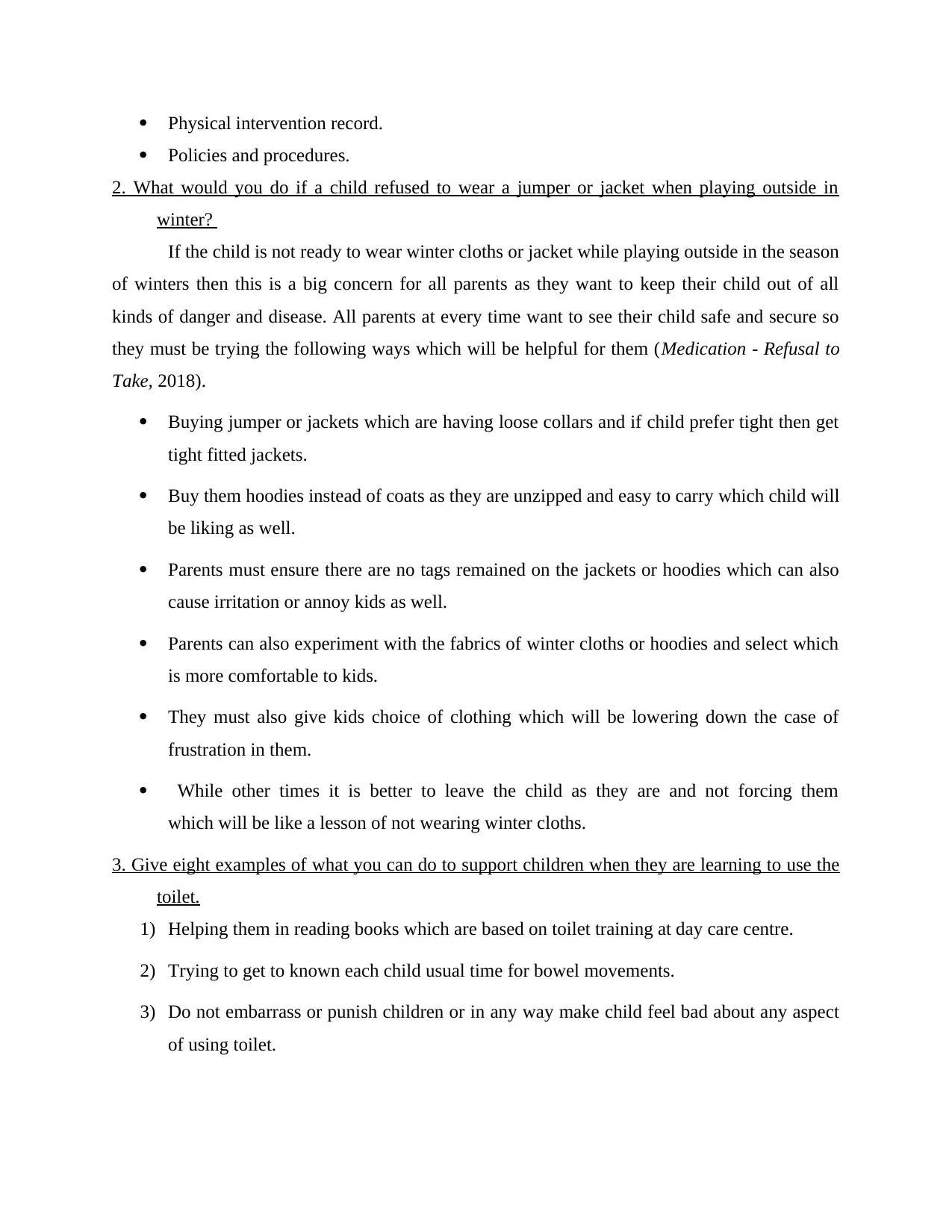
Physical intervention record.
Policies and procedures.
2. What would you do if a child refused to wear a jumper or jacket when playing outside in
winter?
If the child is not ready to wear winter cloths or jacket while playing outside in the season
of winters then this is a big concern for all parents as they want to keep their child out of all
kinds of danger and disease. All parents at every time want to see their child safe and secure so
they must be trying the following ways which will be helpful for them (Medication - Refusal to
Take, 2018).
Buying jumper or jackets which are having loose collars and if child prefer tight then get
tight fitted jackets.
Buy them hoodies instead of coats as they are unzipped and easy to carry which child will
be liking as well.
Parents must ensure there are no tags remained on the jackets or hoodies which can also
cause irritation or annoy kids as well.
Parents can also experiment with the fabrics of winter cloths or hoodies and select which
is more comfortable to kids.
They must also give kids choice of clothing which will be lowering down the case of
frustration in them.
While other times it is better to leave the child as they are and not forcing them
which will be like a lesson of not wearing winter cloths.
3. Give eight examples of what you can do to support children when they are learning to use the
toilet.
1) Helping them in reading books which are based on toilet training at day care centre.
2) Trying to get to known each child usual time for bowel movements.
3) Do not embarrass or punish children or in any way make child feel bad about any aspect
of using toilet.
Policies and procedures.
2. What would you do if a child refused to wear a jumper or jacket when playing outside in
winter?
If the child is not ready to wear winter cloths or jacket while playing outside in the season
of winters then this is a big concern for all parents as they want to keep their child out of all
kinds of danger and disease. All parents at every time want to see their child safe and secure so
they must be trying the following ways which will be helpful for them (Medication - Refusal to
Take, 2018).
Buying jumper or jackets which are having loose collars and if child prefer tight then get
tight fitted jackets.
Buy them hoodies instead of coats as they are unzipped and easy to carry which child will
be liking as well.
Parents must ensure there are no tags remained on the jackets or hoodies which can also
cause irritation or annoy kids as well.
Parents can also experiment with the fabrics of winter cloths or hoodies and select which
is more comfortable to kids.
They must also give kids choice of clothing which will be lowering down the case of
frustration in them.
While other times it is better to leave the child as they are and not forcing them
which will be like a lesson of not wearing winter cloths.
3. Give eight examples of what you can do to support children when they are learning to use the
toilet.
1) Helping them in reading books which are based on toilet training at day care centre.
2) Trying to get to known each child usual time for bowel movements.
3) Do not embarrass or punish children or in any way make child feel bad about any aspect
of using toilet.
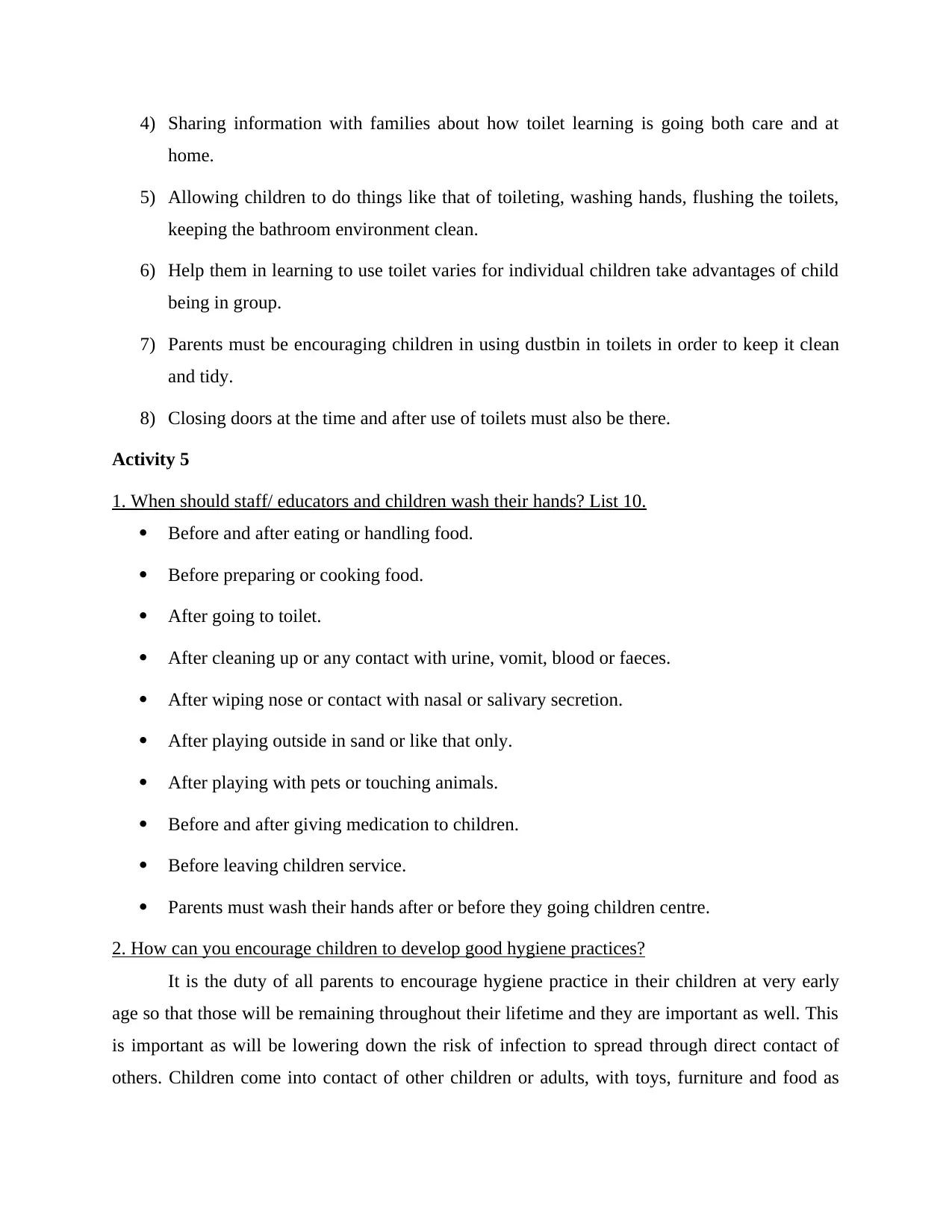
4) Sharing information with families about how toilet learning is going both care and at
home.
5) Allowing children to do things like that of toileting, washing hands, flushing the toilets,
keeping the bathroom environment clean.
6) Help them in learning to use toilet varies for individual children take advantages of child
being in group.
7) Parents must be encouraging children in using dustbin in toilets in order to keep it clean
and tidy.
8) Closing doors at the time and after use of toilets must also be there.
Activity 5
1. When should staff/ educators and children wash their hands? List 10.
Before and after eating or handling food.
Before preparing or cooking food.
After going to toilet.
After cleaning up or any contact with urine, vomit, blood or faeces.
After wiping nose or contact with nasal or salivary secretion.
After playing outside in sand or like that only.
After playing with pets or touching animals.
Before and after giving medication to children.
Before leaving children service.
Parents must wash their hands after or before they going children centre.
2. How can you encourage children to develop good hygiene practices?
It is the duty of all parents to encourage hygiene practice in their children at very early
age so that those will be remaining throughout their lifetime and they are important as well. This
is important as will be lowering down the risk of infection to spread through direct contact of
others. Children come into contact of other children or adults, with toys, furniture and food as
home.
5) Allowing children to do things like that of toileting, washing hands, flushing the toilets,
keeping the bathroom environment clean.
6) Help them in learning to use toilet varies for individual children take advantages of child
being in group.
7) Parents must be encouraging children in using dustbin in toilets in order to keep it clean
and tidy.
8) Closing doors at the time and after use of toilets must also be there.
Activity 5
1. When should staff/ educators and children wash their hands? List 10.
Before and after eating or handling food.
Before preparing or cooking food.
After going to toilet.
After cleaning up or any contact with urine, vomit, blood or faeces.
After wiping nose or contact with nasal or salivary secretion.
After playing outside in sand or like that only.
After playing with pets or touching animals.
Before and after giving medication to children.
Before leaving children service.
Parents must wash their hands after or before they going children centre.
2. How can you encourage children to develop good hygiene practices?
It is the duty of all parents to encourage hygiene practice in their children at very early
age so that those will be remaining throughout their lifetime and they are important as well. This
is important as will be lowering down the risk of infection to spread through direct contact of
others. Children come into contact of other children or adults, with toys, furniture and food as
⊘ This is a preview!⊘
Do you want full access?
Subscribe today to unlock all pages.

Trusted by 1+ million students worldwide
1 out of 41
Related Documents
Your All-in-One AI-Powered Toolkit for Academic Success.
+13062052269
info@desklib.com
Available 24*7 on WhatsApp / Email
![[object Object]](/_next/static/media/star-bottom.7253800d.svg)
Unlock your academic potential
Copyright © 2020–2025 A2Z Services. All Rights Reserved. Developed and managed by ZUCOL.





